Papers and Presentations - 2014
June
Jeff Wisoff Outlines NIF’s Plans for Moving Toward Ignition
Experimental campaigns designed to move NIF closer to fusion ignition in the coming months were described by NIF & PS Principal Associate Director Jeff Wisoff in directorate All-Hands meetings on June 17.
Wisoff said the principal challenge now facing researchers is to build on the success of the current series of high-foot experiments, which have produced record neutron yields, by finding ways to improve fuel compression and areal density while maintaining the implosion stability and low ablator-fuel mixing achieved by the high-foot scheme.
 Jeff Wisoff speaks at an All-Hands meeting.
Jeff Wisoff speaks at an All-Hands meeting. Even though implosion quality has improved dramatically since NIF experiments began in 2011, NIF is still “about a factor of two off” from the combination of pressure and density needed for ignition, Wisoff said. Achieving those conditions would require either tripling NIF’s energy or continuing to make “finesse” improvements in implosion symmetry, laser-hohlraum energy-coupling efficiency, and fuel convergence ratio (the initial fuel radius divided by the imploded fuel radius).
“A goal of the program is to improve understanding and predictive capability so we can be quantitative about what is needed to achieve ignition—how much more energy, how much more finesse,” he said. Upcoming experiments using different hohlraum shapes and fills, alternate capsule materials such as high-density carbon (diamond) and beryllium, careful pulse shaping, and new diagnostic techniques will address remaining issues related to drive symmetry, hohlraum drive and coupling, and capsule stability, Wisoff said.
Wisoff also discussed NIF‘s recent efforts to increase its shot rate in keeping with the recommendations of the 120-day study conducted earlier this year. Among the recommendations were increasing the number of hours dedicated to shots during shot weeks from about 80 to 120, increasing the number of shot weeks per year from 38 to 44, and reducing the time needed to execute each shot.
To test the efficiency improvements, NIF has set an “aggressive goal” of firing 80 target shots in the fourth quarter of Fiscal Year 2014. “Being more productive is just one aspect of becoming a world-class user facility,” Wisoff said.
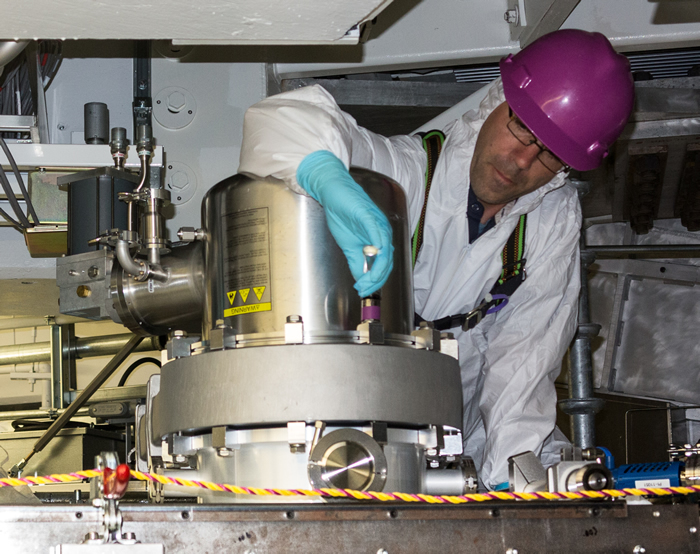 Cryogenic Operations’ Eric Mertens, with Paul Begonia and Russell Spain (not in photo) installs one of the two upgraded cryo pumps on the NIF target positioner (TARPOS). The cryo pumps on TARPOS are the first hardware project as part of the 120-day study recommendations to increase NIF’s shot rate. They will allow parallel operations on TARPOS and CRYOTARPOS, significantly speeding up cryogenic shots.
Cryogenic Operations’ Eric Mertens, with Paul Begonia and Russell Spain (not in photo) installs one of the two upgraded cryo pumps on the NIF target positioner (TARPOS). The cryo pumps on TARPOS are the first hardware project as part of the 120-day study recommendations to increase NIF’s shot rate. They will allow parallel operations on TARPOS and CRYOTARPOS, significantly speeding up cryogenic shots. LLNL Paper Featured in OSA’s “Spotlight on Optics”
A paper by LLNL researchers published on June 16 in Optics Express has been selected as a July “Spotlight on Optics” featured article by the Optical Society of America. The paper, “Nanoscale surface tracking 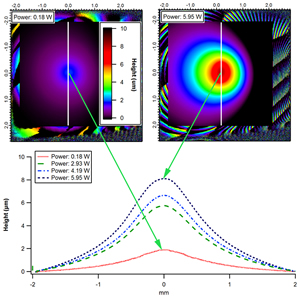 Surface profile of laser-heated fused silica derived from PSDI measurements (both x- and y-scales are in millimeters). The asymmetry from left to right is due to interferometry setup. The 2D phase plots show a region of interest that has been unwrapped and scaled to a height which would be accurate if the sample were at room temperature. Vertical lineouts through the surface profiles illustrate the shape of the expanded region.of laser material processing using phase shifting diffraction interferometry,” describes the use of interferometry measurements as real-time feedback to a silica-based LCVD (laser-based chemical vapor deposition) process to obtain nanometer-scale sensitivity.
Surface profile of laser-heated fused silica derived from PSDI measurements (both x- and y-scales are in millimeters). The asymmetry from left to right is due to interferometry setup. The 2D phase plots show a region of interest that has been unwrapped and scaled to a height which would be accurate if the sample were at room temperature. Vertical lineouts through the surface profiles illustrate the shape of the expanded region.of laser material processing using phase shifting diffraction interferometry,” describes the use of interferometry measurements as real-time feedback to a silica-based LCVD (laser-based chemical vapor deposition) process to obtain nanometer-scale sensitivity.
LCVD is being explored as a method for mitigating laser-induced damage to fused silica optics. LCVD deposits silica over the damaged area and shapes the final surface with nanometer-scale accuracy, resulting in a silica layer with a high damage threshold and a desired surface profile. High-energy laser systems typically require nanometer-scale flatness of mitigated optical surfaces in order to minimize perturbations to the laser light. To meet this requirement, LLNL researchers applied phase-shifting diffraction interferometry (PSDI) measurements of the surface profile to serve as feedback to control the LCVD parameters.
In their Optics Express article, LLNL authors Gabe Guss, Selim Elhadj, Arun Sridharan (now at General Electric) Michael Johnson, and Ibo Matthews show how utilizing PSDI and accounting for the kinetics of the modeled thermomechanical response resulted in increased control of the LCVD process.
Two papers are selected from OSA journals each month to appear in “Spotlight on Optics.” Lead author Guss is an automation engineer who has been instrumental in developing key technologies in the buildup of NIF optics processing. In particular, said corresponding author Ibo Matthews, Guss co-developed the Rapid Ablation Mitigation (RAM) protocol which is a method to repair laser damage on fused silica optics and is used currently to rehabilitate and reuse numerous optics on NIF. Matthews is a simulation expert who modeled the material response to validate results. The other authors also have made significant contributions to NIF&PS projects, Matthews said.
Radiochemical Determination of NIF Capsule Compression
A radiochemical technique for determining the compression of NIF target capsules could also prove useful in stellar nucleosynthesis research, according to LLNL researchers. In a Review of Scientific Instruments paper published online on June 30, the researchers reported on the results of radiochemical measurements of the neutron activation of gold in the hohlraums of NIF inertial confinement fusion (ICF) capsules to demonstrate the usefulness of these measurements to diagnose ICF implosions, as well as to measure neutron cross-sections or cross-section ratios.
They also reported that since NIF ICF implosions occur at temperatures comparable to those in stars, the same technique could be used to measure neutron cross-sections of importance to astrophysics. The neutrons emitted by the imploded capsule (both 14.1 MeV and lower-energy down-scattered neutrons) can induce nuclear reactions, and therefore produce radionuclides, in material located in proximity to the capsule, with the lowest-energy fraction producing (n,γ) and (n,n) products. In contrast, the unscattered neutrons produce few capture products, preferentially forming products of threshold reactions, e.g., (n,2n). The ratio of the concentrations of (n,γ) to (n,2n) products produced in an activation target is related to the fraction of the emitted neutrons that have undergone multiple scattering and is, therefore, related to fuel compression.
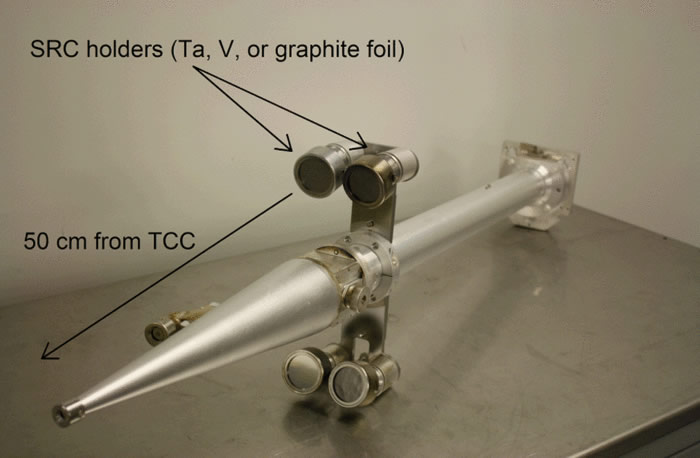 The solid radiochemistry (SRC) debris collectors used in the experiments were fielded in the NIF Target Chamber on a fixed bracket mounted on the outside surface of a retractable diagnostic instrument manipulator. The ICF target assembly at the Target Chamber center was just beyond the end of the snout, 50 centimeters from the SRC holders.
The solid radiochemistry (SRC) debris collectors used in the experiments were fielded in the NIF Target Chamber on a fixed bracket mounted on the outside surface of a retractable diagnostic instrument manipulator. The ICF target assembly at the Target Chamber center was just beyond the end of the snout, 50 centimeters from the SRC holders. “The success of these nuclear isotope and isomer ratio measurements at the NIF suggests that the facility can be used for studies in basic nuclear physics and astrophysics,” the researchers said. “The fuel in an ICF capsule is driven to temperatures and pressures comparable with those found in the interiors of asymptotic giant branch (AGB) stars—low- to medium-mass stars where the s-process (slow-neutron-capture nucleosynthesis) is thought to occur.”
This nucleosynthesis process occurs over a long time period by capture of neutrons generated by the nuclear reactions in the star. Depending on the mass, composition, and stage of evolution of the AGB star, the s-process produces elements heavier than iron up to yttrium and strontium, and even up to lead under some conditions. “These heavy elements can be ejected into the interstellar medium by a supernova explosion,” they said. “Although the neutron spectrum produced by an ICF capsule is dominated by 14-MeV neutrons, there can be a significant contribution from neutrons that mimic those that produce heavy elements via the s-process.”
Lead author Dawn Shaughnessy was joined on the paper by LLNL colleagues Ken Moody, Narek Gharibyan, Pat Grant, Julie Gostic, Phil Torretto, Todd Wooddy, Bryan Bandong, Charlie Cerjan, Chris Hagmann, Joseph Caggiano, Charles Yeamans, Lee Bernstein, Dieter Schneider, Eugene Henry, and Dick Fortner and by John Despotopulos of LLNL and the Radiochemistry Program at the University of Nevada Las Vegas.
MIT’s Petrasso Discusses D3He Experiments on NIF
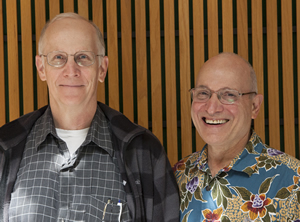 Richard Petrasso (right) with NIF seminar host Bruce Remington.
Richard Petrasso (right) with NIF seminar host Bruce Remington. Richard Petrasso, head of the HED physics division at the MIT Plasma Science and Fusion Center, discussed upcoming two-shock experiments on NIF using high-density carbon (diamond) capsules during a NIF HED science seminar on June 18.
Petrasso said the experiments planned for this fall “will allow us to see for the first time both the shock and compression bang time” during fusion implosions. “Right now on NIF all we’re seeing is the compression bang time.”
Petrasso said proton spectrometers (wedge range filters) on the equator and pole, sensitive to both shock and compression deuterium-helium-3 (D3He) protons produced by the shots, will simultaneously measure areal density (ρR) growth and ρR asymmetry swings at both the pole and equator during the critical shock-compression interval when ρR is rapidly increasing. These data, along with other key diagnostic data, should provide an insightful test of hydrodynamic simulations.
Petrasso also discussed the results of D3He “exploding pusher” experiments on the OMEGA Laser System at the University of Rochester and the platform’s potential relevance to NIF implosions, as well as its promise as a monoenergetic backlighter for NIF HED science.
Observation of a Reflected Shock in a NIF Implosion
The small size of the compressed core, or hot spot, in a NIF implosion, as well as the short duration of the implosion, have made it challenging to observe the various steps of hot-spot formation. The first step of a central hot-spot ignition experiment is the convergence and reflection of a strong spherical shock, ahead of the converging dense shell of thermonuclear fuel and ablator. 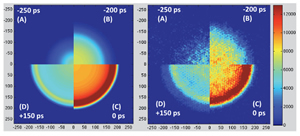 Simulated (left) and measured (right) x-ray images of the DD implosion. The simulations’ absolute values have been multiplied by 1.3 and plotted on the same absolute scale. The converging shock reaches the origin (A), bounces back and expands outward (B) [time of peak neutron emission]. Peak x-ray emission happens once the shock heats the in-falling plastic ablator (C). Shock reflection on the ablator and continuing compression reheat the center while the outgoing shock lights up the silicon dopant in the outer layers of the ablator (D). The color bar is in arbitrary units. The (A) and (B) images are multiplied by a factor of 2.5 to increase their visibility.The shock sequence of a spherical implosion has three phases: 1) a strong shock travels into the gas; 2) when it arrives at the center of the capsule it is reflected on itself; and 3) adiabatic compression is caused by the fuel and ablator shell converging and compressing the hot spot.
Simulated (left) and measured (right) x-ray images of the DD implosion. The simulations’ absolute values have been multiplied by 1.3 and plotted on the same absolute scale. The converging shock reaches the origin (A), bounces back and expands outward (B) [time of peak neutron emission]. Peak x-ray emission happens once the shock heats the in-falling plastic ablator (C). Shock reflection on the ablator and continuing compression reheat the center while the outgoing shock lights up the silicon dopant in the outer layers of the ablator (D). The color bar is in arbitrary units. The (A) and (B) images are multiplied by a factor of 2.5 to increase their visibility.The shock sequence of a spherical implosion has three phases: 1) a strong shock travels into the gas; 2) when it arrives at the center of the capsule it is reflected on itself; and 3) adiabatic compression is caused by the fuel and ablator shell converging and compressing the hot spot.
The first detailed observation of the second phase of the spherical implosion, when the shock is reflected in a low-convergence (five times) indirectly driven implosion under ignition-relevant conditions, was reported in a Physical Review Letters paper by LLNL researchers and collaborators published online on June 4. This was achieved by using a near-vacuum hohlraum to provide a fast-rising symmetric drive on a thin (120-micron) plastic capsule reaching very high velocity (more than 500 km/s). The ablator acted as a pusher on the high-pressure deuterium (DD) fill, launching a strong converging shock that reached two gigabars (Gbar) after rebound. The implosion exhibited ideal one-dimensional behavior and 99 percent laser-to-hohlraum coupling.
The researchers said the finding provides insight into the thermal conductivity in an ignition-relevant hot, dense DD plasma. The precise capture of the dynamics of the reflected shock x-ray emission, coupled to neutron diagnostics, are consistent with (nonflux limited) Spitzer-Harm theory within the framework of one-dimensional hydrodynamics. This observation provides a theoretical and numerical framework to design a higher-convergence cryogenic layered deuterium-tritium (DT) implosion driven by a vacuum hohlraum. Such a high-efficiency, laser-plasma-interaction-free hohlraum platform could drive a high-density carbon capsule to velocities approaching 400 km/s, at convergence of more than 20 times. For a cryogenic layered DT implosion, this is predicted to achieve a hot-spot pressure of 200 Gbar and noticeable alpha heating, the researchers said.
Lead author Sebastian Le Pape was joined by LLNL colleagues and collaborators from the MIT Plasma Science and Fusion Center, Los Alamos National Laboratory, the Laboratory for Laser Energetics at the University of Rochester, and General Atomics Corp. of La Jolla.



